| |
|
|
|
|
|
|
|
|
|
|
| |
| |
 |
|
| |
田润德 编译文/图 2020-08-22
19:36 |
|
| |
|
|
|
|
| |
 |
|
|
|
| |
贝拉·巴托克(Béla Bartók,1881-1945)与他的第二任妻子迪塔·帕斯托里(Ditta
Pásztory) |
|
|
|
| |
|
|
| |
【席夫】巴托克E大调第三钢琴协奏曲
|
|
|
|
| |
András Schiff Bartók Piano
Concerto No.3 in E major Sz |
|
|
|
| |
|
|
|
|
| |
音乐历史上的今天
1945年9月26日,在纽约西区医院,64岁的贝拉·巴托克在和白血病的斗争中败下阵来。“我的父亲直到生命的最后一刻还在作曲。医生进来时,他正在写献给我母亲的《第三钢琴协奏曲》的尾声。他恳求医生让他在家里多待一天,但医生们很坚决。一个星期之后,父亲过世了。最后
17个小节不得不由蒂博尔·谢尔伊(Tibor Serly)完成。”(彼得.巴托克/ 作者专访)。
贝拉·巴托克(Béla Viktor János
Bartók,1881年3月25日-1945年9月26日)作曲家、音乐学家、钢琴家,出生于匈牙利纳吉圣米克洛斯(今罗马尼亚境内),不仅是匈牙利现代音乐的泰斗,也是二十世纪最杰出的音乐家之一。作为作曲家、民间音乐学家,他的很多创举剧烈震动了整个20世纪艺术圈,
一些专家们甚至坚信他的才华可以与贝多芬相提并论。
巴托克5岁开始随母亲学琴,9岁开始作曲,10岁开始公开演出自己的习作和贝多芬的钢琴奏鸣曲,1903年毕业于布达佩斯音乐学院。巴托克1905年开始从事匈牙利民歌(后来范围甚至扩大到东欧各国、北非和土耳其)收集、整理与研究工作,收集了大量的民歌,出版了相关的民歌曲集、研究专著与理论文章,取得了卓越的音乐学研究成就。这项艰巨而宏富的工作,更激发了他源源不断的创作灵感,并促成了他鲜明的创作风格:民族音调与现代节奏、丰富多声的精妙结合。
巴托克本人曾自我总结自己的音乐创作:“创作匈牙利‘新’艺术音乐的基础终于奠定了,第一,掌握过去和当代的西方艺术音乐的普遍知识,作为创作技巧;第二,以新近发掘出来的乡村音乐——一种无可比拟的完美材料,作为作品的灵魂。”
如今,他创作的诸如歌剧《蓝胡子公爵的城堡》、管弦乐《舞蹈组曲》、《为弦乐、打击乐与钢片琴而作的音乐》、《乐队协奏曲》、三部《钢琴协奏曲》等等,特别是他最杰出的六部《弦乐四重奏》,已经成为二十世纪音乐宝库里闪闪发光的明珠。
今日视频:1、席夫演奏巴托克E大调第三钢琴协奏曲
;2、祖克曼演奏巴托克《中提琴协奏曲 》;3、皮埃尔·布列兹指挥柏林爱乐乐团演奏巴托克的管弦乐《为弦乐器、打击乐和钢片琴而作》。 |
|
|
|
| |
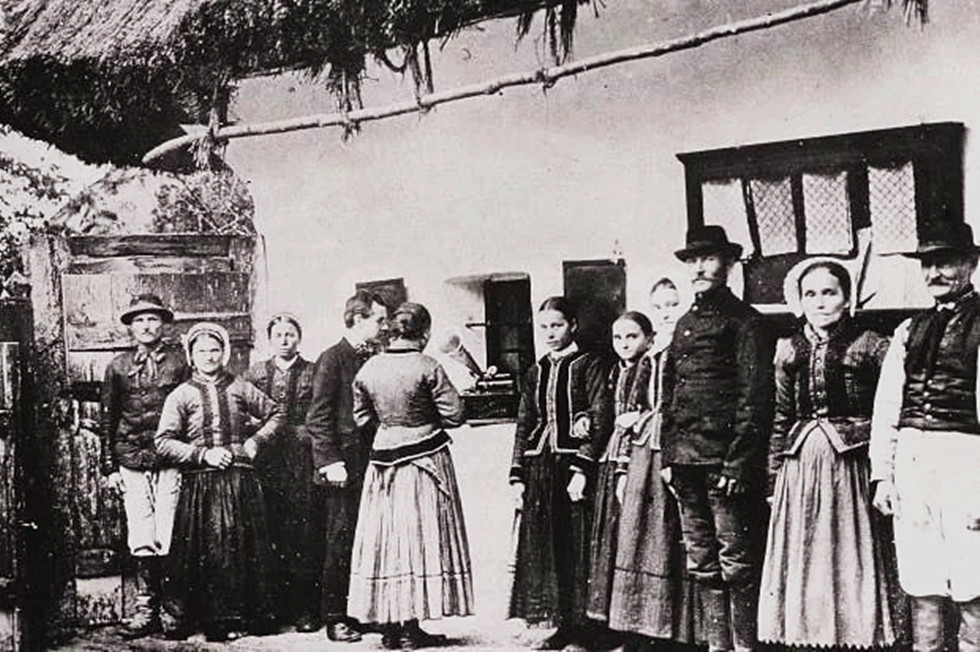 |
|
| |
巴托克和农民在一起(Béla Bartók)在特兰西瓦尼亚记录民歌 |
|
|
|
| |
Béla Bartók spent
time with farmers and recorded folk songs in Transylvania. |
|
|
|
| |
贝拉·巴托克小传 |
|
|
|
| |
贝拉·维克托·雅诺斯·巴托克是匈牙利的一位作曲家、钢琴家以及东欧和中东民间音乐的收集者。巴托克被认为是 20
世纪最伟大的作曲家之一。他是民族音乐学领域的奠基人之一,该学科是对民间音乐的研究与民族志的探索。
贝拉·巴托克在父亲于 1888 年去世后,便开始跟随母亲学习音乐。1894
年,他们定居在布拉迪斯拉发,在那里他就读于中学(多尼亚尼是他的年长同学),并师从拉兹洛·埃尔克尔和安东·赫尔特尔学习钢琴,同时创作了奏鸣曲和四重奏。1898
年,他被维也纳音乐学院录取,但随后跟随多尼亚尼前往布达佩斯学院(1899 年至 1903
年),在那里他师从弗朗茨·李斯特的学生伊斯特万·托马森学习钢琴,师从扬诺斯·科斯勒学习作曲。在那里,他进一步熟悉了瓦格纳的作品,不过
1902 年在布达佩斯《查拉图斯特拉如是说》的首演中遇到的施特劳斯的音乐对他影响最大。他创作了一首交响诗《科苏斯》(1903
年),采用了施特劳斯的方法,并融入了弗朗茨·李斯特风格的匈牙利元素。
1904
年,科苏斯这部作品在布达佩斯和曼彻斯特上演;与此同时,贝拉·巴托克开始以钢琴家的身份展开职业生涯,创作了《钢琴五重奏》以及两首具有李斯特风格的炫技曲目(《幻想曲》第
1 号、《谐谑曲》第 2 号)。同年,他还首次完成了匈牙利民歌的转录工作。1905
年,他收集了更多歌曲,并开始与佐尔坦·科达伊合作:他们的首批改编作品于 1906
年出版。次年,他被任命为布达佩斯学院的托马恩的继任者,这使他得以在匈牙利定居并继续进行民歌收集工作,尤其是在特兰西瓦尼亚地区。与此同时,他的音乐开始受到这一活动以及由
Z. 科达伊从巴黎带回的德彪西音乐的影响:这两者都开辟了新的、基于模态的和不规则节拍的和声方式。1908
年的《小提琴协奏曲》仍属于交响乐传统范畴,但这一时期的许多小钢琴曲则展现出一个崭新的、具有真正匈牙利特色的巴托克形象,其中包括匈牙利民歌的四度音程、农民舞蹈的节奏以及他在匈牙利、罗马尼亚和斯洛伐克民族中发现的音阶。这位新作曲家的这一创作风格在他的《第一弦乐四重奏》(1908
年)中有所体现,该作品于 1910 年在布达佩斯的一场他的音乐作品演奏会上首次亮相。
随后是管弦乐曲和一部独幕歌剧《蓝胡子的城堡》,这是献给他的年轻妻子的。这部作品受到了穆索尔斯基和德彪西的影响,但最直接的灵感来源于匈牙利民间音乐(以及施特劳斯在其管弦乐作品中的表现),这是一部关于人类孤独的阴郁寓言。然而,这部作品在参赛时未能胜出。在两年时间里(1912年至1914年),巴托克几乎放弃了作曲,转而致力于收集、编排和研究民间音乐,直到第一次世界大战终结了他的探险活动。他于1917年创作了第二部弦乐四重奏和童话芭蕾舞剧《木头王子》,该剧于1917年在布达佩斯上演,使他重新获得了公众的青睐。次年,《蓝胡子的城堡》上演,他开始创作第二部芭蕾舞剧《神奇的太监》,该剧直到1926年才上演(因为对主题存在争议,即性爱的阻碍与实现)。这部作品构思丰富、画面生动,几乎是一部没有台词的歌剧。
在创作《曼陀林组曲》时,贝拉·巴托克受到了伊戈尔·斯特拉文斯基和阿诺德·勋伯格的影响,并在 1921 至 1922
年的两首小提琴奏鸣曲中创作出了他最为复杂的音乐作品。与此同时,他开始获得国际声誉:他的作品由环球版社出版,并且他受邀在欧洲各地演奏这些作品。此时,他在国内也已站稳了脚跟。他为纪念布达佩斯成立
50 周年举办的一场音乐会创作了自信的《舞曲组曲》(1923 年),不过在此之前,他的创作活动又陷入了短暂的停滞期,直到
1926
年突然爆发创作热潮,创作了包括第一钢琴协奏曲、钢琴奏鸣曲和《户外组曲》在内的作品。这些作品将钢琴作为打击乐器来运用,利用其共鸣以及木琴般的硬度。在接下来的两部弦乐四重奏(1927
至 1928 年)中,他继续探索新的音色和强烈的节奏,第四部弦乐四重奏就像协奏曲一样,采用了五段式回文结构(ABCBA)。
在第二钢琴协奏曲(1931 年)和第五弦乐四重奏(1934
年)中,也采用了类似的严谨的对位手法,不过贝拉·巴托克的和声此时已趋于趋向于调性化。从内在的半音进行转向明亮的主调(尽管带有模态色彩)的这种转变,是《弦乐、打击乐与钢片琴音乐》(1936
年)和《两架钢琴与打击乐奏鸣曲》(1937 年)的基础,这两部作品是为瑞士演出而创作的,当时匈牙利的政治局势愈发令人不满。
1940 年,贝拉·巴托克和他的第二任妻子(他们于 1923
年离婚并再次结婚)怀着悲痛的心情离开了战火纷飞的欧洲,前往纽约生活。他觉得纽约与自己格格不入。他们举办了音乐会,期间他还获得了研究经费,用于编纂一套南斯拉夫民歌集,但他们的经济状况十分不稳定,他的健康状况也日益恶化。似乎他最后的欧洲作品——第
6 号弦乐四重奏(1939 年)可能就是他悲观的绝笔之作,但随后出现了充满活力的管弦乐协奏曲(1943
年)和复杂的独奏小提琴奏鸣曲(1944
年)。为给他的遗孀提供收入而创作的第三钢琴协奏曲在他去世时几乎已完成,而一首草稿阶段的中提琴协奏曲也留存了下来。
|
|
|
|
| |
 |
|
|
|
| |
孩童时代的贝拉·巴托克 |
|
|
|
| |
Bela Bartók in his
childhood |
|
|
|
| |
 |
|
|
|
| |
年轻的贝拉·巴托克 |
|
|
|
| |
The young Bela Bartók |
|
|
|
| |
Biography
of Bela Bartók
Bela Viktor Janos Bartók was a Hungarian composer, pianist, and
collector of folk music from Eastern Europe and the Middle East.
Bartók is regarded as one of the greatest composers of the 20th
century. He was one of the founders of the field of
ethnomusicology, which is the study of folk music and the
exploration of ethnography.
After his father died in 1888, Bela Bartók began to learn music
from his mother. In 1894, they settled in Bratislava, where he
attended a secondary school (Donianny was his senior classmate)
and studied piano under László Erkel and Antón Hertel, while
also composing sonatas and quartets. In 1898, he was admitted to
the Vienna Conservatory of Music, but later followed Donianny to
the Budapest Academy (from 1899 to 1903), where he studied piano
under István Thomason, a student of Franz Liszt, and composition
under Janos Kosler. There, he became more familiar with Wagner's
works, but the music of Strauss he encountered at the premiere
of "Thus Spoke Zarathustra" in Budapest in 1902 had the greatest
impact on him. He composed a symphonic poem "Cosus" (1903),
using Strauss's methods and incorporating Hungarian elements in
the style of Franz Liszt.
In 1904, this work "Cosus" was performed in Budapest and
Manchester; at the same time, Bela Bartók began his career as a
pianist, creating "Piano Quintet" and two virtuoso pieces in the
style of Liszt (Fantasia No. 1, Rondo No. 2). The same year, he
also completed the transcription of Hungarian folk songs. In
1905, he collected more songs and began to collaborate with
Zoltán Kodály: their first adaptations were published in 1906.
The following year, he was appointed as Thomann's successor at
the Budapest Academy, which enabled him to settle in Hungary and
continue his folk music collection work, especially in
Transylvania. At the same time, his music began to be influenced
by this activity and the music of Debussy brought back from
Paris by Z. Kodály: both of these had opened up new, modal and
irregular rhythm-based harmonic ways. The "Violin Concerto" of
1908 still belonged to the symphonic tradition, but many of the
small piano pieces from this period showed a new, truly
Hungarian image of Bartók, including the fourth-degree intervals
of Hungarian folk songs, the rhythms of peasant dances, and the
scales he discovered in Hungarian, Romanian and Slovak ethnic
groups. This new compositional style of this young composer was
reflected in his "First String Quartet" (1908), which made its
debut at a concert of his musical works in Budapest in 1910. |
|
|
|
| |
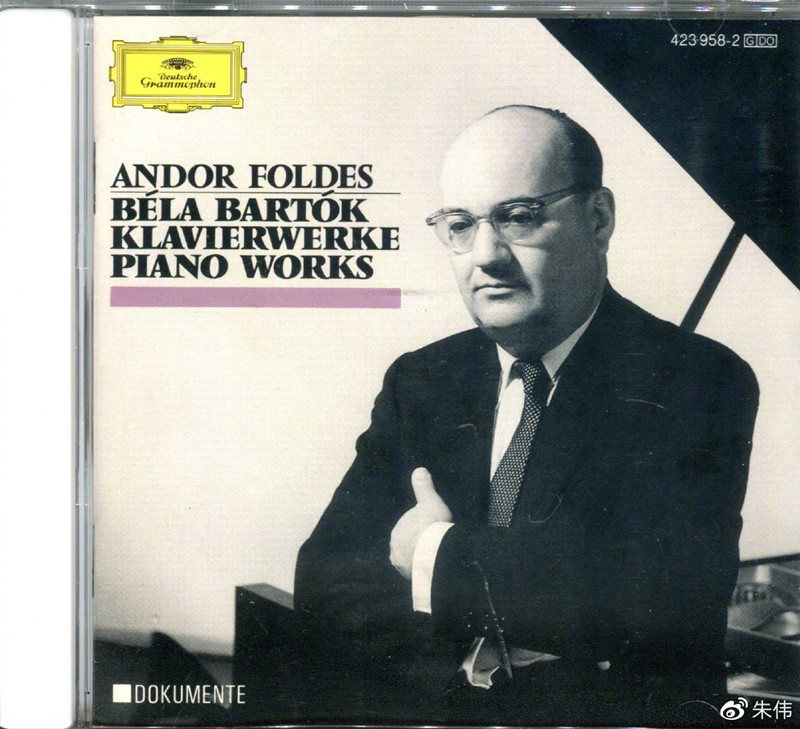 |
|
|
|
| |
巴托克的《钢琴奏鸣曲》作于1926年,献给第二任妻子Ditta
Pástory-Bartók。巴托克是1923年与第一任妻子玛尔塔·齐格勒离婚,与学生Ditta
Pástory-Bartók结婚的。此曲3乐章都短小:第一乐章中板,钢琴奏出打击乐节奏性的第一主题,第二主题则有歌唱性;发展部有斯特拉文斯基影响,追逐音很有特色。第二乐章和缓沉重地,主题像上下、忽远忽近的深夜钟声,三段体,中段节奏略有变化。第三乐章是快速舞曲的回旋曲式,欢欣追逐,插段节奏变化,有小抒情。 |
|
 |
|
| |
|
|
|
|
| |
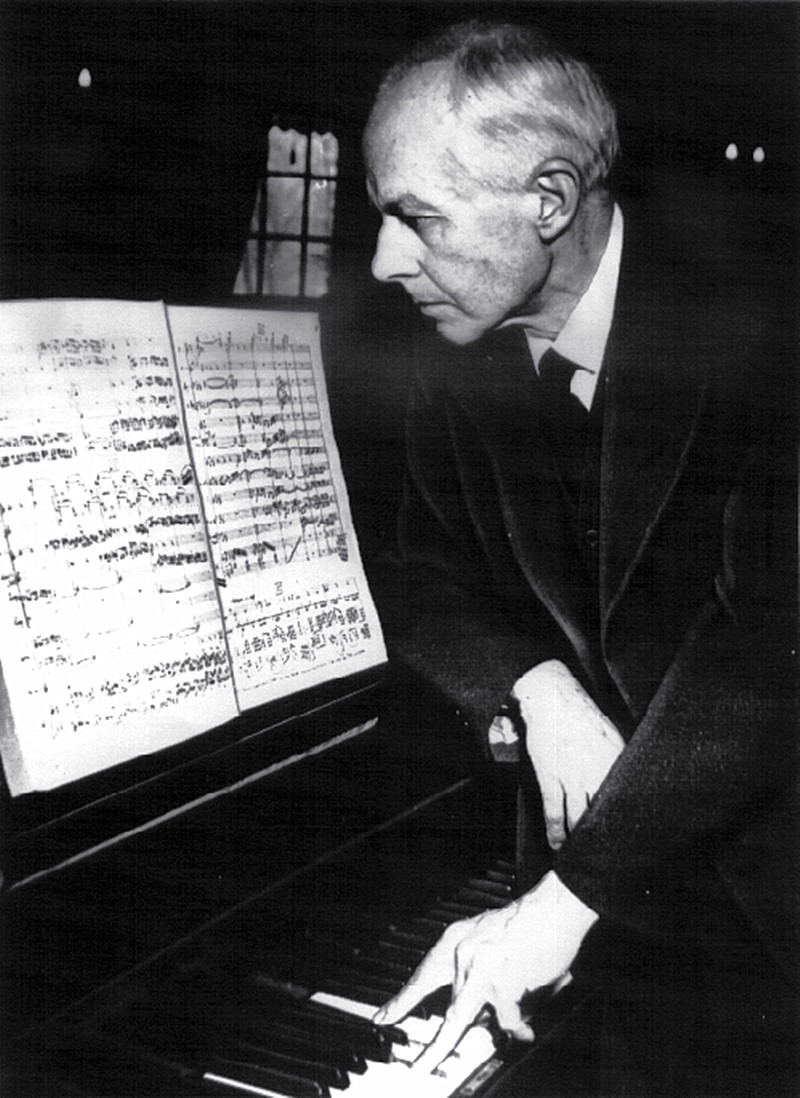 |
|
| |
贝拉·巴托克创作中 |
|
|
|
| |
巴托克《第三钢琴协奏曲》 |
|
|
|
| |
巴托克
献给妻子迪塔·帕斯托里的《第三钢琴协奏曲》,作于1945
年。这实际是巴托克的最后一部作品,他逝世前还剩下几小节未完成,是他的朋友塞利帮助他补全的。
这部作品 1946年2月8日由费城交响乐团首演。桑多尔独奏,奥曼迪指挥。它的三个乐章是,1.小快板。在颤动的中提琴和第二小提琴之上,钢琴奏出一个单旋律,以切分节奏随意装饰着,使人想起民间舞蹈节奏。第一小提琴在钢琴颤音的背景上奏出相似的调子,引出一组副主题。发展部在钢琴深厚的连击琶音声中,以开头旋律的扩展开始,基本主题随小提琴的一系列下行颤音开始再现,下行三度的音型虽然出现,并在单簧管、长笛、双篢管和独奏钢琴之间相互呼应,结束部逐步消失。2.柔板
,宗教的,这部分弦乐器在旋律上相互模仿着,令人想起文艺复兴时期的经文歌。它与钢琴独奏的众赞歌或赞美诗般的乐句轮换出现。在对比性中段中,在一片轻微的、不协和的小提琴颤音的背景之上,木管和钢琴奏出极短小的反复动机,似乎是阵阵鸟语。当开始素材重现时,众赞歌般的乐句是由木管组奏出的。3.活泼的快板
。开始主题的鲜明节奏再次暗示了民间舞蹈,在此转而成为一个回旋曲的叠句。定音鼓独奏引入的对比性插段具精心设计和丰富高深的对位性,结尾是急板。 |
|
|
|
| |
Bartók's
Third Piano Concerto was composed in 1945. This is actually
Bartók's last work. Before his death, he still had a few short
sections unfinished, which were completed by his friend Szilard.
This work was premiered by the Philadelphia Symphony Orchestra
on February 8, 1946. Sandor played the solo, and Omandi
conducted. Its three movements are: 1. Allegro. Above the
tremolo violins and second violins, the piano plays a single
melody, decorated with syncopated rhythms freely, reminiscent of
folk dance rhythms. The first violin plays a similar melody on
the background of piano tremolos, leading to a group of
secondary themes. The development section begins with the
expansion of the initial melody in the deep plucked琶音 of the
piano, and the basic theme is re-presented by the violin series
of descending tremolos, while the descending third interval
pattern appears and echoes among the oboe, flute, double bass,
and solo piano, gradually disappearing in the ending part. 2.
Adagio, slow tempo. In this part, the string instruments imitate
each other on the melody, reminiscent of the liturgical songs of
the Renaissance period. It alternates with the solo songs or
hymn-like phrases of the steel. In the contrasting middle
section, on a background of slight and dissonant violin
tremolos, woodwinds and piano play extremely short repetitive
motives, seemingly like the sounds of birds. When the initial
material is repeated, the chorale-like phrases are played by the
woodwind group. 3
The lively allegro movement, with the distinct rhythm of the
theme once again hinting at folk dance, now transforms into a
rondo refrain. The contrasting interlude introduced by the
timpani solo is meticulously designed and rich in complex
counterpoint, and the ending is allegro. |
|
|
|
| |
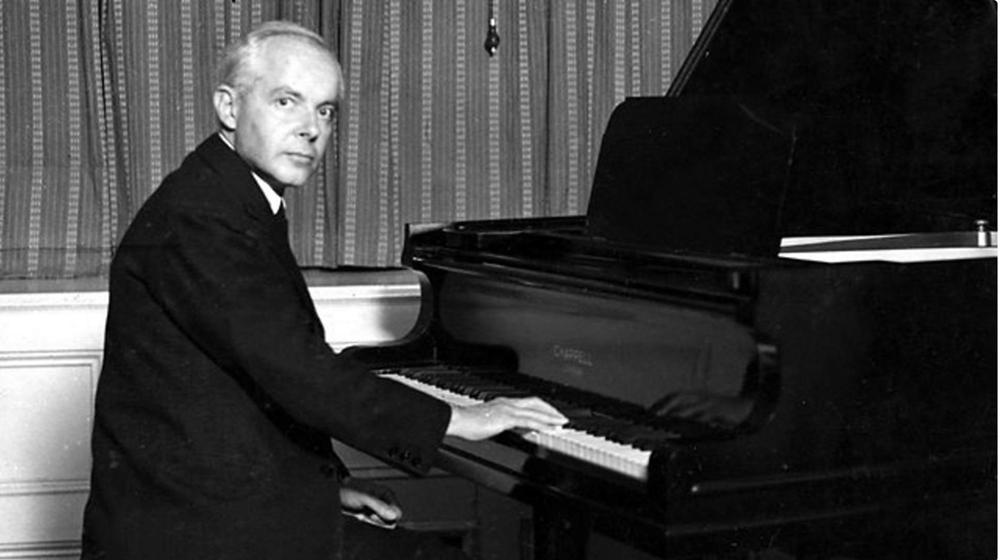 |
|
| |
贝拉·巴托克创作中 |
|
|
|
| |
1938年10月24日,巴托克去美国之前又写道,“必须离开这里,离开这个瘟神(德国)的身边。我要走,走得远远地。但是,上哪儿去呢?格陵兰?好望角?火地岛?斐济?上帝知道去哪儿才好1”
巴托克是出于无奈才离开匈牙利的。科达伊说得对,巴托克
要是不走的话,他那耿直的性格肯定会使他横遭迫害,甚至殉难。但是,巴托克的声音是压制不了的。他要说的话尽在音乐之中。——摘自《巴托克传》(拉约什·莱斯瑙伊) |
|
|
|
| |
On October
24, 1938, before leaving for the United States, Bartók wrote
again, "I must leave this place, leave the side of this demon
(Germany). I'm going, far away. But where to go? Greenland? Cape
of Good Hope? Tierra del Fuego? Fiji? God knows where would be
best."
Bartók left Hungary out of necessity. Kodály was right. If
Bartók didn't leave, his straightforward nature would surely
have led to persecution and even martyrdom. But Bartók's voice
couldn't be suppressed. What he wanted to say was all in his
music. - Excerpted from "Bartók's Biography" (Rákosy László) |
|
|
|
| |
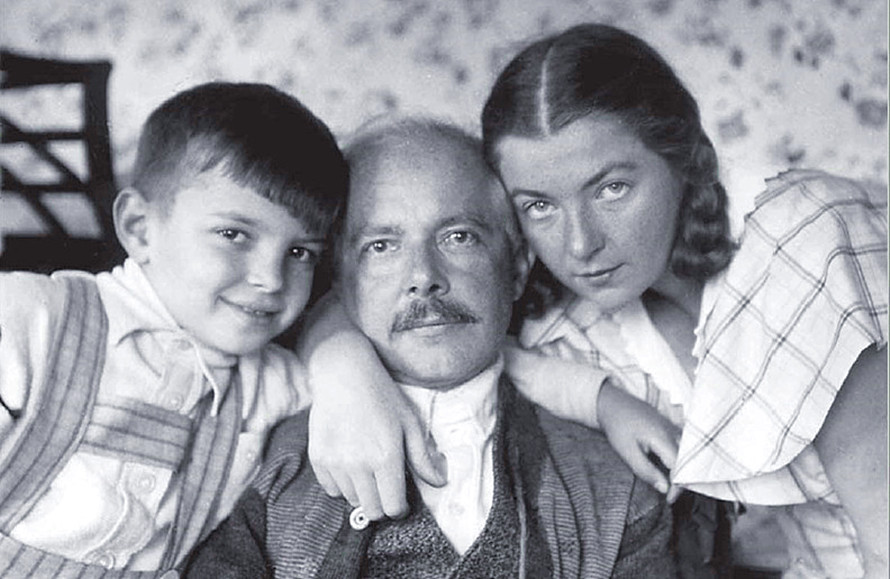 |
|
|
|
| |
与他的第二任妻子迪塔·帕斯托里以及他们的儿子彼得,1932 年 10 月。照片由迪塔·帕斯托里拍摄。 |
|
|
|
| |
With his second wife Ditta Pásztory and their son Péter, October
1932. Photo Ditta Pásztory |
|
|
|
| |
Today in
Music History
September 26, 1945, in the West Side Hospital in New York,
64-year-old Béla Bartók succumbed to leukemia. "My father
continued composing until the very end of his life. When the
doctor came in, he was writing the ending of the 'Third Piano
Concerto' dedicated to my mother. He pleaded with the doctor to
let him stay at home for one more day, but the doctors were very
firm. A week later, my father passed away. The last 17 bars had
to be completed by Tibor Serly." (Peter Bartók / Author
Interview)
Béla Viktor János Bartók (March 25, 1881 - September 26, 1945)
was a composer, musicologist, and pianist. He was born in
Nagyszentmiklós, Hungary (now in Romania). He was not only a
leading figure in modern Hungarian music but also one of the
most outstanding musicians of the 20th century. As a composer
and folk musicologist, many of his innovations shook the entire
20th-century art circle. Some experts even believed that his
talent could be compared to that of Beethoven.
Bartók began learning the piano with his mother at the age of 5,
started composing at the age of 9, and began performing his own
compositions and Beethoven's piano sonatas publicly at the age
of 10. He graduated from the Budapest Conservatory in 1903. In
1905, Bartók began to engage in the collection, organization,
and research of Hungarian folk songs (later the scope expanded
to Eastern Europe countries, North Africa, and Turkey),
collecting a large number of folk songs, publishing related folk
song collections, research monographs, and theoretical articles,
and achieving outstanding achievements in musicological
research. This arduous and rich work further stimulated his
continuous creative inspiration and led to his distinct creative
style: the exquisite combination of ethnic tones and modern
rhythms, and the rich polyphony.
Bartók himself once summarized his musical creation: "The
foundation for creating 'new' Hungarian art music has finally
been laid. First, master the general knowledge of past and
contemporary Western art music as a creative technique; second,
use the newly discovered rural music - an incomparably perfect
material - as the soul of the work."
Today, his creations such as the opera "The Castle of Duke
Bluebeard", the orchestral "Dance Suite", "Music for String,
Percussion, and Steelpan", "Concerto for Orchestra", three
"Piano Concertos", etc., especially his most outstanding six
"String Quartets", have become shining gems in the treasure
house of 20th-century music.
Today's video: 1. Schiff performs Bartók's E Major Third Piano
Concerto; 2. Zukerman performs Bartók's Viola Concerto; 3.
Pierre Boulez conducts the Berlin Philharmonic Orchestra to
perform Bartók's orchestral piece "For Strings, Percussion and
Steelpan". |
|
|
|
| |
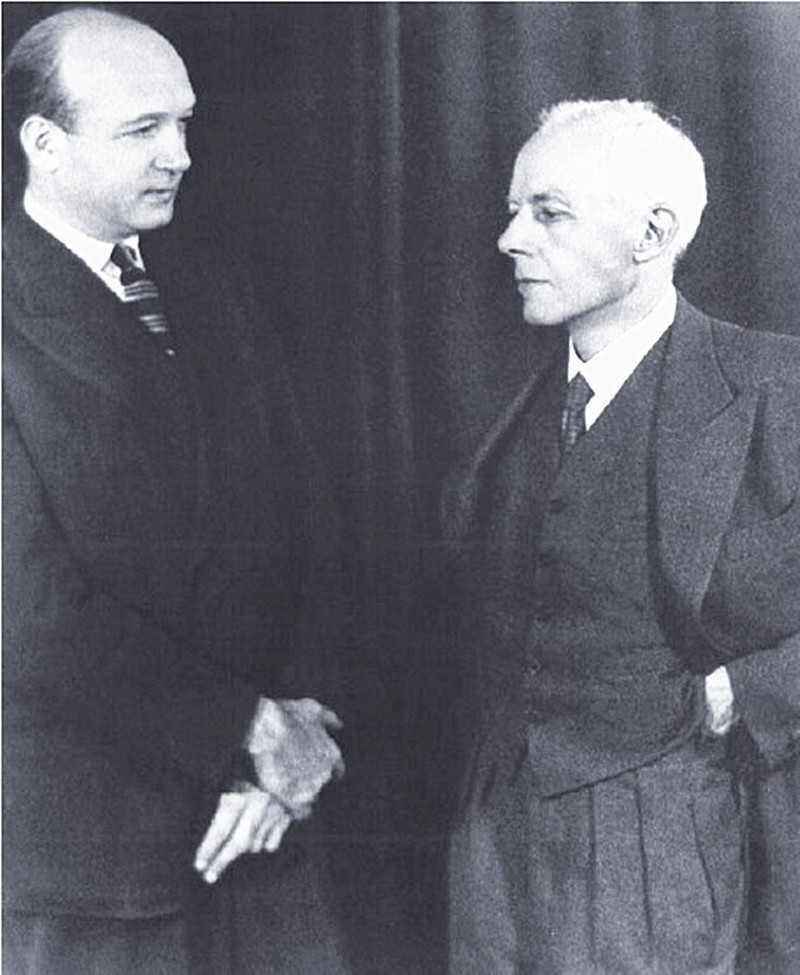 |
|
| |
1940年 2
月于纽约,与小提琴家约瑟夫·西盖蒂赴美演出时的合影,并以流亡者身份抵达纽约,同时在哥伦比亚大学授予荣誉博士学位,从事研究工作。照片由欧内斯特·纳什拍摄。
约瑟夫·西盖蒂(Joseph Szigeti)——匈牙利小提琴演奏家(1892-1973) |
|
|
|
| |
In February 1924 in
New York, a photo taken during a performance with the violinist
Joseph Segatti, upon arriving in New York as a refugee and being
awarded an honorary doctorate by Columbia University, and
engaging in research work. The photo was taken by Ernest Nash. |
|
|
|
| |
 |
|
| |
巴托克贝拉和帕斯托里达在美国的经历
"在美国巡回演出或许是我们在世时经历过的最艰难、最令人不安的时光了。”——巴托克 |
|
|
|
| |
BARTÓK BÉLA ÉS
PÁSZTORY DITTA AMERIKÁBAN
A Bartók házaspár amerikai tartózkodása életük talán legnehezebb
és legboldogtalanabb időszaka volt. |
|
|
|
| |
 |
|
| |
巴托克贝拉和帕斯托里 |
|
|
|
| |
Bartók Bela and
Pastori |
|
|
|
| |
 |
|
|
|
| |
巴托克贝拉和帕斯托里共同的儿子彼得·巴托克 |
|
|
|
| |
The son of Béla
Bartók and Pasculi, Peter Bartók, who was born jointly to them. |
|
|
|
| |
 |
|
| |
贝拉·巴托克在美国的哥伦比亚大学 |
|
|
|
| |
Bella Bartok at
Columbia University in the United States |
|
|
|
| |
|
|
|
|
| |
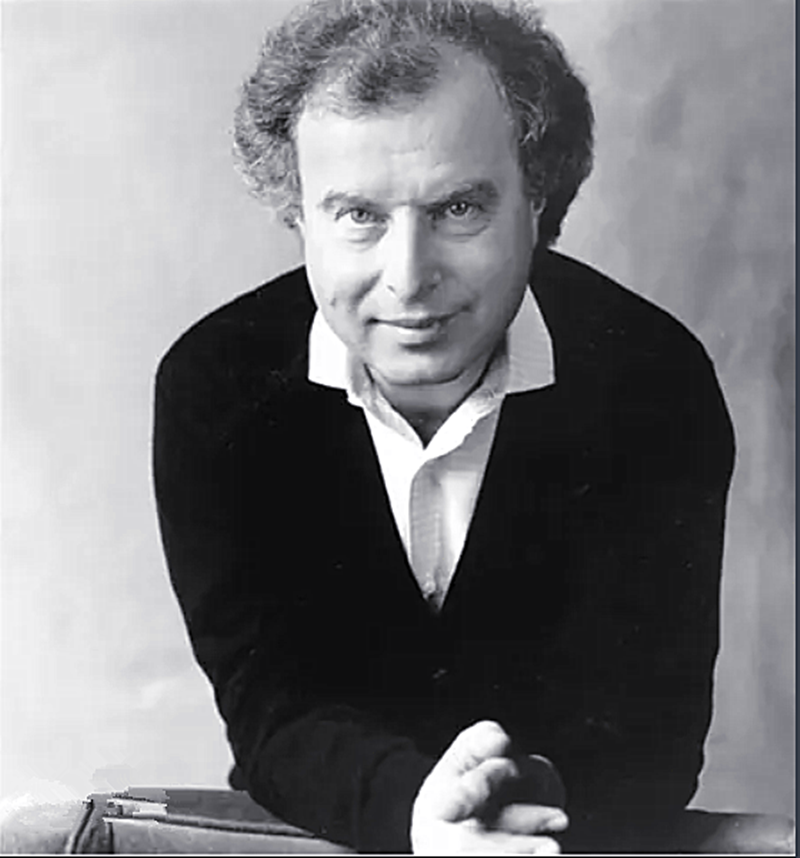 |
|
|
|
| |
安德拉什·席夫(AndrásSchiff),1953年12月21日出生于布达佩斯,匈牙利钢琴家。5岁起随沃达斯学习钢琴,15岁在匈牙利电台举办的“发掘音乐天才”钢琴比赛中获第一名,同年入李斯特音乐学院学习,随考多绍教授等深造,并在伦敦师从马尔科姆学习大键琴。1973年在匈牙利国家广播钢琴比赛中获第二名,1974年参加柴可夫斯基国际比赛获第四名,与同时代人兰基、科奇什一起被称为匈牙利钢琴三杰。后加入奥地利国籍。
|
|
|
|
| |
|
|
| |
祖克曼 & 巴托克-中提琴协奏曲
|
|
|
|
| |
Bartok: Viola Concerto Op.Posth -
Pinchas Zukerman - |
|
|
|
| |
Bartok: Viola Concerto - Pinchas
Zukerman - Robert Trevino - Euskadiko Orkestra 7月18日
2022年 -Bela Bartok (1881-1945): Concierto para viola
y orquesta, Op.Posth (edición de Tibor Serly) I.
Moderato (0:20) II. Adagio religioso (13:10) III.
Allegro vivace (16:53) Boosey and Hawkes Music
Publishers Ltd. Euskadiko Orkestra / Basque National
Orchestra Robert Treviño, zuzendaria / director
Pinchas Zukerman, biola / viola Grabazioa /
Grabación: Euskalduna, Bilbao, 06/2022. ETBk
egindako grabazioa eta 2022ko uztailaren 2an ETB2n
estreinatutakoa / Grabación realizada por ETB y
estrenada en ETB2 el 2 de julio del 2022. Programa
honen babesleak / Patrocinadores de este programa:
Kutxa Fundazioa, Vital Fundazioa, BBK |
|
|
|
| |
巴托克在1944年还有别的约稿。中提琴家威廉•
普里姆罗斯请他写一部中提琴协奏曲。巴托克迟迟未允,因为他人很不舒服,不敢保证能否坚持写完。现在所说的巴托克的中提琴协奏曲事实上不是他的真迹。他死后留下的只是协奏曲的草稿。1945年
9月8日信中提到这部作品时说,它事实上已完成,只剩下配器没写。这部协奏曲是巴托克在美国的一个朋友蒂伯·塞利根据草稿续成的。1949年由普里姆罗斯首次演出。 |
|
|
|
| |
In 1944, Bartók received other commissions as well.
The violist William Primrose asked him to write a
viola concerto. Bartók was reluctant to accept it
because he was feeling unwell and couldn't guarantee
that he would be able to complete it. The so-called
Bartók's viola concerto is actually not his original
work. What he left behind after his death was only
the draft of the concerto. In a letter dated
September 8, 1945, it was mentioned that this work
was actually completed, with only the orchestration
remaining to be written. This concerto was completed
by Tibor Sele, a friend of Bartók in the United
States, based on the draft. It was first performed
by Primrose in 1949. |
|
|
|
| |
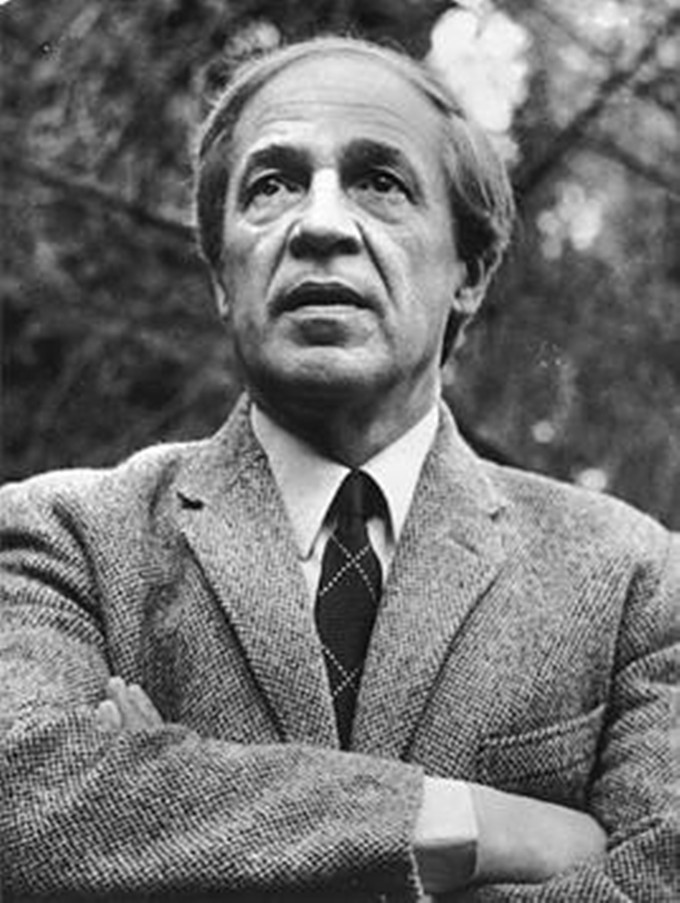 |
|
|
|
| |
指挥介绍:皮埃尔·布列兹Pierre
boulez |
|
|
|
| |
皮埃尔·布列兹 |
|
|
|
| |
皮埃尔·布列兹首先是优秀的现代作曲家,其次才是指挥家。布列兹在巴黎音乐学院学习期间,拜梅西安为师,随他学和声,随莱博维茨学十二音技法,随奥涅格的妻子沃拉布尔学对位。布列兹在指挥中强调节奏的魅力,强调现代作品在节奏中呈现的色彩感,也强调音响效果。布烈兹自己就是一位现代派的作曲家,他一生都在推动二十世纪现代音乐的发展。他对巴尔托克的理解和推崇,使得巴托克的音乐得以发扬,让更多的人知道了伟大的巴托克。布列兹还演绎的他自己的作品、梅西安、巴托克、贝尔格的作品,都堪称为权威。 |
|
|
|
| |
|
|
|
|
| |
|
|
| |
巴托克的神作... 柏林爱乐乐团(Berliner Philharmoniker)指挥:皮埃尔·布列兹(Pierre Boulez)
|
|
|
|
| |
1937年1月21日—贝拉·巴托克的《为弦乐器、打击乐和钢片琴而作》首演于巴塞尔。这首作品充分证实了巴托克的伟大的艺术才华,在此曲中他实践了作者综合德彪西优美的和
声、贝多芬严密的结构、巴赫杰出的复调,创造出一种富于活力的现代风格的理想。 |
|
|
|
| |
巴尔托克
(1881-1945),匈牙利伟大的现代作曲家。巴尔托克 1894 年
起就师从当时匈牙利的名指挥埃尔凯尔学指挥,1899
年入布达佩斯音乐学院深造,他的第1部作品是音乐诗《科苏特》作手 1903
年),他的成功之作是芭雷舞剧《木刻王子》(作于
1914~1916年)。巴尔托克这首乐曲乃受托为巴塞尔室内乐队成立十周年而作,完成于1936年9月7日,1937年1月21
日在保罗•扎赫尔指挥下由该乐队首演手巴塞尔。9个月后,这部作品就传到美国,由巴比罗里指挥纽约爱乐乐团在美国首演。这个作品由两个弦乐组、竖琴、钢琴,及响弦的小鼓、无响弦的小鼓、钹、锣、大鼓、定音鼓、木琴等打击乐组演奏。全曲分为四个乐章:1速度缓慢的赋格曲,2.舞曲般的奏鸣曲结构,快板。3.
柔格,这个类似夜曲似的慢乐章以木琴的独奏始,充满诗意,中段有一个弦乐颤音与竖琴、钢琴和钢片零的滑奏共同构成的印象主义的闪光网。4.极快板,以较复杂的回旋曲构成,以弦乐组剧烈的毫无节制开头,平息下去后,有一个保加利亚民间舞曲的节奏,然后是大齐奏规模宏大的尾声。
布烈兹自己就是一位现代派的作曲家,他一生都在推动二十世纪现代音乐的发展。他对巴尔托克的理解,使得柏林爱乐表现出这部作品极为精彩的结构。 |
|
|
|
| |
|
|
|
|
| |
|
|
|
|
| |
未得原作者编者授权严禁转载www.mt77.com任何内容 |
|
|
|
|
|
|
|
|
|
|
|
|
|
|


